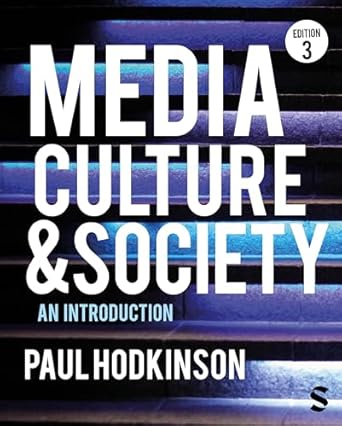Key Highlights
- •Comprehensive and accessible introduction to Media, Culture, and Society.
- •Fully updated 3rd Edition incorporating digital media and contemporary issues.
- •Written by leading academic Paul Hodkinson, known for clear explanations.
Description
Ever wonder how media shapes our world, from the news you watch to the memes you share? Dive into Media, Culture and Society: An Introduction 3rd Edition by Paul Hodkinson! This book is your essential guide to understanding the powerful forces that connect media, culture, and our everyday lives.
Who is this book for? It’s perfect for students just starting out in media studies, sociology, communication, or cultural studies. But it's also great for anyone curious about how TV, the internet, advertising, and social media actually influence our society and shape our perspectives. If you're looking for a clear, comprehensive guide to complex ideas, this book is definately for you.
What problem does this book solve? Feeling lost in a sea of jargon like 'globalization', 'audience reception', or 'cultural identity'? This book break down these big concepts and theories in an easy-to-understand way. It helps you connect the dots between the media you consume daily and the broader cultural and social patterns. No more feeling confused about how media industries operate or how different audiences interpret messages. It provide a solid framework for analysis.
What will you gain from reading it? By reading this book, you'll get a strong foundation in key media and cultural theories. You'll learn how to critically analyze various media forms – from traditional news and film to contemporary digital platforms and social media. You'll understand the big debates about media effects, representation, and the role of media in shaping identities.
Why is it worth reading? This isn't just any introduction; it's the updated 3rd edition, packed with fresh examples and insightful analysis relevant to today's fast-changing digital landscape. Paul Hodkinson makes potentially tricky subjects surprisingly accessible and engaging. Its a highly reccomended and widely used text for a reason – it offers a balanced, thorough, and up-to-date look at the crucial interplay between media, culture, and society.
Ready to make sense of the modern media world? Grab your PDF copy now and start exploring!
FAQ
Is this book suitable for someone with no background in media studies?
Yes, absolutely! It's specifically designed as an introduction. It explains key concepts and theories clearly, making it perfect for beginners in media studies, sociology, or related fields.
Does this 3rd edition cover recent developments like social media?
It sure does. This updated edition includes significant discussion on digital media, the internet, social media platforms, and their impact on culture and society, keeping the content relevant.
Is the writing style overly academic or difficult to follow?
While it covers academic theories, Paul Hodkinson is known for his clear and accessible writing style. The book aims to make complex ideas understandable for students and general readers.
What specific topics can I expect to learn about?
You'll cover a wide range, including media production, media texts and representation, audience interpretation, cultural identity, globalization, the impact of digital technologies, and key theoretical approaches to studying media.
Is this book theoretical, or does it include real-world examples?
It effectively balances theory with contemporary, real-world examples from various media (like news, film, TV, and online platforms) to illustrate the concepts and make them easier to grasp.
How quickly will I receive the PDF after purchase?
Typically, you should recieve an email with the PDF download link within 1-6 hours after your purchase is confirmed.
Reader Reviews
About the Author
Paul Hodkinson is a prominent academic figure in media, communication, and cultural studies, currently based at the University of Surrey. He has published extensively on topics like youth cultures (particularly goth culture), online communication, and the relationship between media, identity, and community. His work is known for its clarity and insightful analysis, making complex sociological and cultural concepts accessible to students.
